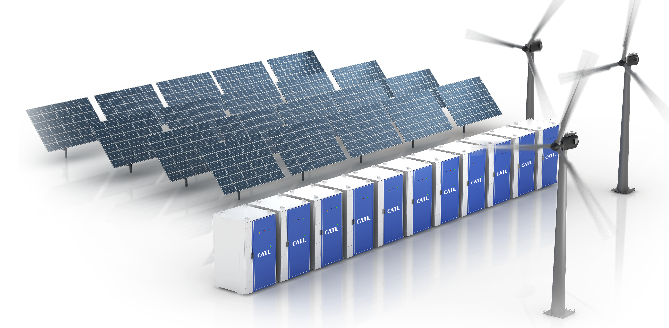- Home
- OFweek News
- Spain Declares State of Emergency: The Energy Storage Crisis Behind the Massive Blackout
Spain Declares State of Emergency: The Energy Storage Crisis Behind the Massive Blackout
Published: April 29, 2025 16:33
Beginning at 12:30 PM on April 28, 2025, Spain, Portugal, and southern France experienced a sudden power outage lasting nearly 10 hours, affecting more than 50 million people.
Transportation systems collapsed (Madrid metro ceased operations, airports closed), communications networks failed (internet connectivity dropped 37%), and a healthcare crisis emerged (inadequate backup power led to fatalities among critically ill patients).Furthermore, industrial shutdowns resulted in losses exceeding €20 billion (with the automotive manufacturing sector alone suffering €1.8 billion in daily losses), while financial markets reeled (Spain's IBEX 35 index plummeted 11%).
Spain had triumphantly announced a "100% renewable energy supply milestone" for its national grid just six days prior, an achievement now directly undermining the credibility of Europe's aggressive energy transition strategy.
While renewable energy sources account for 67% of Spain's energy mix, complementary storage capacity represents a mere 0.3% of power demand, exposing a critical structural imbalance between rapidly expanding wind and solar installations and severely lagging energy storage infrastructure.
Root Cause Analysis: The Energy Storage "Domino Effect"
1. Immediate Triggers
Grid Oscillation Collapse: Extreme temperature fluctuations in Spain's interior triggered abnormal oscillations in 400kV transmission lines, resulting in the loss of 15GW of power (60% of national demand) within just 5 seconds.
Regional Isolation Effect: The Iberian Peninsula's interconnection rate with the European continental grid stands at only 6-7%, preventing cross-border power sharing as a crisis mitigation measure.
2. Fundamental Vulnerabilities
Critical Storage Deficit:
Spain's energy storage capacity of just 2.1GWh (against a 2030 target of 40GWh) proved woefully inadequate to buffer fluctuations in renewable output (wind power generation plunged 83% while solar efficiency dropped 10% on the day of the incident).
Aging Infrastructure:
70% of transmission lines are operating beyond their intended service life, with a digitalization rate of only 40% (compared to Germany's 75%), resulting in sluggish fault response capabilities.
Policy Misalignment:
Between 2015-2025, investments in renewable energy exceeded €80 billion, while grid modernization received just €12 billion, with energy storage subsidy mechanisms lagging significantly behind.
Policy Developments: Europe's Energy Storage Market Catalyst
1. Emergency Capital Injection
The European Union has approved €700 million in specialized storage subsidies for Spain (covering 80-120 projects), while Portugal has launched a €100 million battery storage initiative (targeting 500MW capacity).
Spain has revised its National Energy and Climate Plan, increasing 2030 storage targets from 20GW to 22.5GW.
2. Accelerated Transnational Cooperation
The France-Spain Bay of Biscay submarine cable (scheduled for 2028 commissioning) will increase interconnection capacity to 5GW, establishing a "Southwestern European Power Alliance" regional backup power pool.
The EU's "Grid Resilience Act" now mandates that member states achieve 15% storage penetration and double cross-border interconnection capacity.
Future Outlook: Warning Signs and Lessons for Global Energy Transitions
1. Systemic Risk Warnings
Comprehensive Decarbonization Requirements: Spain's premature decommissioning of 7.3GW of coal-fired capacity undermined baseload power availability, highlighting the necessity of a tripartite integration of "renewables + storage + flexible power sources."
Lessons for China: Comparative analysis with China's 2025 new energy storage installation target (exceeding 70GW) reveals policy divergences (such as market-based incentive mechanisms that replaced mandatory storage requirements).
2. Corporate Opportunities
European Storage Market Growth Projections: 2024 will see new installations of 11.9GW/21.1GWh, with 15GW of projects concentrated between 2026-2027.
Strategic Positioning for Chinese Enterprises: Companies can capitalize on the EU's preferential below-3% tariff advantage while strengthening localized service networks (exemplified by Sungrow's European operations center deployment).

source: CATL
Conclusion
Spain's massive blackout represents not merely an isolated technical failure, but rather the concentrated manifestation of tensions between 'aggressive targets' and 'system resilience' in the global energy transition. Flow batteries, grid-forming storage technologies, coupled with transnational grid interconnections and supportive policies, may ultimately reshape the 'stability genome' of power systems. This crisis serves as a stark reminder to the world: carbon neutrality is not a simple competition of installation capacity, but rather a systems engineering challenge fundamentally dependent on energy storage technologies.
